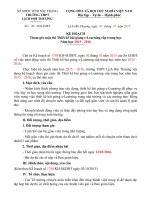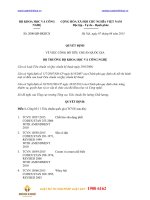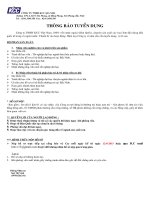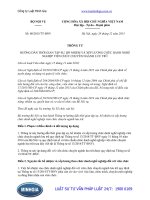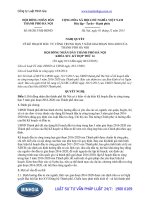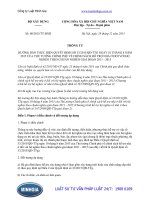E 458 08 (2015)
Bạn đang xem bản rút gọn của tài liệu. Xem và tải ngay bản đầy đủ của tài liệu tại đây (122.86 KB, 7 trang )
Designation: E458 − 08 (Reapproved 2015)
Standard Test Method for
Heat of Ablation1
This standard is issued under the fixed designation E458; the number immediately following the designation indicates the year of
original adoption or, in the case of revision, the year of last revision. A number in parentheses indicates the year of last reapproval. A
superscript epsilon (´) indicates an editorial change since the last revision or reapproval.
This standard has been approved for use by agencies of the U.S. Department of Defense.
tion of both the material and the environment to which it is
subjected. In general, it is defined as the incident heat dissipated by the ablative material per unit of mass removed, or
1. Scope
1.1 This test method covers determination of the heat of
ablation of materials subjected to thermal environments requiring the use of ablation as an energy dissipation process. Three
concepts of the parameter are described and defined: cold wall,
effective, and thermochemical heat of ablation.
1.2 This standard does not purport to address all of the
safety concerns, if any, associated with its use. It is the
responsibility of the user of this standard to establish appropriate safety and health practices and determine the applicability of regulatory limitations prior to use.
Q* 5 q/m
(1)
where:
Q*
= heat of ablation, kJ/kg,
q
= incident heat transfer rate, kW/m2, and
m
= total mass transfer rate, kg/m2·s.
3.1.2 The heat of ablation may be represented in three
different ways depending on the investigator’s requirements:
3.1.3 cold-wall heat of ablation—The most commonly and
easily determined value is the cold-wall heat of ablation, and is
defined as the incident cold-wall heat dissipated per unit mass
of material ablated, as follows:
2. Referenced Documents
2.1 ASTM Standards:2
E285 Test Method for Oxyacetylene Ablation Testing of
Thermal Insulation Materials
E422 Test Method for Measuring Heat Flux Using a WaterCooled Calorimeter
E457 Test Method for Measuring Heat-Transfer Rate Using
a Thermal Capacitance (Slug) Calorimeter
E459 Test Method for Measuring Heat Transfer Rate Using
a Thin-Skin Calorimeter
E511 Test Method for Measuring Heat Flux Using a CopperConstantan Circular Foil, Heat-Flux Transducer
E617 Specification for Laboratory Weights and Precision
Mass Standards
Q* cw 5 q cw/m
(2)
where:
Q*cw = cold-wall heat of ablation, kJ/kg,
= heat transfer rate from the test environment to a cold
qcw
wall, kW/m2, and
m
= total mass transfer rate, kg/m2·s.
The temperature of the cold-wall reference for the cold-wall
heat transfer rate is usually considered to be room temperature
or close enough such that the hot-wall correction given in Eq
8 is less than 5 % of the cold-wall heat transfer rate.
3.1.4 effective heat of ablation—The effective heat of ablation is defined as the incident hot-wall heat dissipated per unit
mass ablated, as follows:
3. Terminology
3.1 Descriptions of Terms Specific to This Standard:
3.1.1 heat of ablation—a parameter that indicates the ability
of a material to provide heat protection when used as a
sacrificial thermal protection device. The parameter is a func-
Q* eff 5 q hw/m
(3)
where:
Q*eff = effective heat of ablation, kJ/kg,
= heat transfer rate from the test environment to a
qhw
nonablating wall at the surface temperature of the
material under test, kW/m2, and
m
= total mass transfer rate, kg/m2·s.
3.1.5 thermochemical heat of ablation—The derivation of
the thermochemical heat of ablation originated with the
simplistic surface energy equation employed in the early 60s to
describe the effects of surface ablation, that is:
1
This test method is under the jurisdiction of ASTM Committee E21 on Space
Simulation and Applications of Space Technology and is the direct responsibility of
Subcommittee E21.08 on Thermal Protection.
Current edition approved May 1, 2015. Published June 2015. Originally
approved in 1972. Last previous edition approved in 2008 as E458–08. DOI:
10.1520/E0458-08R15.
2
For referenced ASTM standards, visit the ASTM website, www.astm.org, or
contact ASTM Customer Service at For Annual Book of ASTM
Standards volume information, refer to the standard’s Document Summary page on
the ASTM website.
q hw 2 q rr 5 q cond1q abl1q block
Copyright © ASTM International, 100 Barr Harbor Drive, PO Box C700, West Conshohocken, PA 19428-2959. United States
1
(4)
E458 − 08 (2015)
pressure, gas composition, heat transfer rate, mode of heat
transfer, and gas enthalpy. As laboratory duplication of all
parameters is usually difficult, the user of the data should
consider the differences between the service and the test
environments. Screening tests of various materials under simulated use conditions may be quite valuable even if all the
service environmental parameters are not available. These tests
are useful in material selection studies, materials development
work, and many other areas.
4.2 Steady-State Conditions—The nature of the definition of
heat of ablation requires steady-state conditions. Variances
from steady-state may be required in certain circumstances;
however, it must be realized that transient phenomena make the
values obtained functions of the test duration and therefore
make material comparisons difficult.
4.2.1 Temperature Requirements—In a steady-state
condition, the temperature propagation into the material will
move at the same velocity as the gas-ablation surface interface.
A constant distance is maintained between the ablation surface
and the isotherm representing the temperature front. Under
steady-state ablation the mass loss and length change are
linearly related.
where:
= energy re-radiated from the heated surface, kW/m2,
qrr
qcond = net energy conducted into the solid during steadystate ablation = mcp(Tw − To), kW/m2,
= energy absorbed by surface ablation which, in
qabl
simple terms, can be represented by m∆ Hv, kW/m2,
qblock = energy dissipated (blockage) by transpiration of
ablation products into the boundary layer, which, in
simple terms, can be represented by mη(hr − hw),
kW/m2,
= absolute surface temperature of ablating material, K,
Tw
= specific heat at constant pressure of ablating
cp
material, kJ/kg·K,
= initial surface temperature of ablating material, K,
To
∆Hv = an effective heat of vaporization, kJ/kg,
η
= a transpiration coefficient,
= gas recovery enthalpy, kJ/kg, and
hr
= the wall enthalpy, kJ/kg.
hw
Using the definitions above, Eq 4 can be rewritten as:
q hw 2 q rr 5 mcp ~ T w 2 T o ! 1m∆H v 1mη ~ h r 2 h w !
(5)
where it should be apparent that the definition of the thermochemical heat of ablation is obtained by dividing Eq 4 by
m, where it is understood that m is a steady-state ablation
rate. The result is:
Q* tc 5 ~ q hw 2 q rr! /m 5 c p ~ T w 2 T o ! 1∆H v 1η ~ h r 2 h w !
mt 5 ρ o δ L 1 ~ ρ o 2 ρ c ! δ c
(7)
where:
t
= test time, s,
ρo = virgin material density, kg/m3,
δL = change in length or ablation depth, m,
ρc = char density, kg/m3, and
δc = char depth, m.
This relationship may be used to verify the existence of
steady-state ablation in the tests of charring ablators.
4.2.2 Exposure Time Requirements—The exposure time required to achieve steady-state may be determined experimentally by the use of multiple models by plotting the total mass
loss as a function of the exposure time. The point at which the
curve departs significantly from linearity is the minimum
exposure time required for steady-state ablation to be established. Cases exist, however, in the area of very high heating
rates and high shear where this type of test for steady-state may
not be possible.
(6)
As seen from Eq 6, definition of the thermochemical heat
of ablation requires an ability to measure the cold-wall heat
flux, an ability to define the recovery enthalpy, an ability to
measure the surface temperature, knowledge of the total
hemispherical emittance (at the temperature and state of the
ablating surface), and the ability to determine the steadystate mass loss rate. Assuming these parameters can be measured (or estimated), the right hand side of Eq 6 implies that
the thermochemical heat of ablation is a linear function of
the enthalpy difference across the boundary layer, that is,
(hr − hw). Consequently, a plot of Q*tc (determined from several tests at different conditions) versus (hr − hw) should
allow a linear fit of the data where the slope of the fit is interpreted as η, the transpiration coefficient, and the
y-intercept is interpreted as cp∆ T + ∆Hv. If the specific heat
of the material is known, the curve fit allows the effective
heat of vaporization to be empirically derived.
5. Determination of Heat Transfer Rate
5.1 Cold-Wall Heat Transfer Rate:
5.1.1 Determine the cold-wall heat transfer rate to a specimen by using a calorimeter. These instruments are available
commercially in several different types, some of which can be
readily fabricated by the investigator. Selection of a specific
type is based on the test configuration and the methods used,
and should take into consideration such parameters as instrument response time, test duration, and heat transfer rate (13).
5.1.1.1 The calorimeters discussed in 5.1.1 measure a “coldwall” heat transfer rate because the calorimeter surface temperature is much less than the ablation temperature. The value
thus obtained is used directly in computing the cold-wall heat
of ablation.
3.2 The three heat of ablation values described in 3.1.2
require two basic determinations: the heat transfer rate and the
mass transfer rate. These two quantities then assume various
forms depending on the particular heat of ablation value being
determined.
4. Significance and Use
4.1 General—The heat of ablation provides a measure of the
ability of a material to serve as a heat protection element in a
severe thermal environment. The parameter is a function of
both the material and the environment to which it is subjected.
It is therefore required that laboratory measurements of heat of
ablation simulate the service environment as closely as possible. Some of the parameters affecting the heat of ablation are
3
The boldface numbers in parentheses refer to the references listed at the end of
the standard.
2
E458 − 08 (2015)
5.4 Reradiation Correction:
5.4.1 Calculate the heat transfer rate due to reradiation from
the surface of the ablating material from the following equation:
5.1.2 Install the calorimeter in a calorimeter body that
duplicates the test model in size and configuration. This is done
in order to eliminate geometric parameters from the heat
transfer rate measurement and to ensure that the quantity
measured is representative of the heat transfer rate to the test
model. If the particular test run does not allow an independent
heat transfer rate measurement, as in some nozzle liner and
pipe flow tests, mount the calorimeter as near as possible to the
location of the mass-loss measurements. Take care to ensure
that the nonablating calorimeter does not affect the flow over
the area under test. In axisymmetric flow fields, measurements
of mass loss and heat transfer rate in the same plane, yet
diametrically opposed, should be valid.
q rr 5 σεT w 4
where:
σ = Stefan-Boltzmann constant, and,
ε = thermal emittance of the ablating surface.
5.4.2 Eq 9 assumes radiation through a transparent medium
to a blackbody at absolute zero. Consider the validity of this
assumption for each case and if the optical properties of the
boundary layer are known and are deemed significant, or the
absolute zero blackbody sink assumption is violated, consider
these effects in the use of Eq 9.
5.2 Computation of Effective and Thermochemical Heats of
Ablation:
5.2.1 In order to compute the effective and thermochemical
heats of ablation, correct the cold-wall heat transfer rate for the
effect of the temperature difference on the heat transfer. This
correction factor is a function of the ratio of the enthalpy
potentials across the boundary layer for the hot and cold wall
as follows:
q hw/q cw 5 @ ~ h e 2 h hw! / ~ h e 2 h cw! #
(9)
5.5 Mechanical Removal Correction:
5.5.1 Determine the heat transfer rate due to the mechanical
removal of material from the ablating surface from the massloss rate due to mechanical processes and the enthalpy of the
material removed as follows:
q mech 5 m mechh m
(8)
(10)
5.5.2 Approximate the enthalpy of the material removed by
the product of the specific heat of the mechanically removed
material, and the surface temperature (9-13).
where:
he
= gas recovery enthalpy at the boundary layer edge,
kJ/kg,
hhw = gas enthalpy at the surface temperature of the test
model, kJ/kg, and
hcw = gas enthalpy at a cold wall, kJ/kg.
6. Determination of Mass Transfer Rate
6.1 The determination of the heat of ablation requires the
measurement of the mass transfer rate of the material under
test. This may be accomplished in several ways depending on
the type of material under test. The heat of ablation value can
be affected by the choice of method.
6.1.1 Ablation Depth Method:
6.1.1.1 The simplest method of measurement of mass-loss
rate is the change in length or ablation depth. Make a pretest
and post-test measurement of the length and calculate the
mass-loss rate from the following relationship:
5.2.2 This correction is based upon laminar flow in air and
subject to the restrictions imposed in Ref (2). Additional
corrections may be required regarding the effect of temperature
on the transport properties of the test gas. The form and use of
these corrections should be determined by the investigator for
each individual situation.
5.3 Gas Enthalpy Determination:
5.3.1 The enthalpy at the boundary layer edge may be
determined in several ways: energy balance, enthalpy probe,
spectroscopy, etc. Details of the methods may be found
elsewhere (3-6). Take care to evaluate the radial variation of
enthalpy in the nozzle. Also, in low-density flows, consider the
effect of nonequilibrium on the evaluation. Determination of
the gas enthalpy at the ablator surface and the calorimeter
surface requires pressure and surface temperature measurements. The hot-wall temperatures are generally measured by
optical methods such as pyrometers, radiometers, etc. Other
methods such as infrared spectrometers and monochromators
have been used (7,8). Effects of the optical properties of the
boundary layer of an ablating surface make accurate determinations of surface temperature difficult.
5.3.2 Determine the wall enthalpy from the assumed state of
the gas flow (equilibrium, frozen, or nonequilibrium), if the
pressure and the wall temperature are known. It is further
assumed that the wall enthalpy is the enthalpy of the freestream
gas, without ablation products, at the wall temperature. Make
the wall static pressure measurements with an ordinary pitot
arrangement designed for the flow regime of interest and by
using the appropriate transducers.
m 5 ρ o ~ δ L /t !
(11)
6.1.1.2 Determine the change in length with the time of a
model under test, by using motion picture techniques. Note that
observation of the front surface alone does not, however, verify
the existence of steady state ablation. Take care, however, to
provide appropriate reference marks for measuring the length
change from the film. Timing marks on the film are also
required to accurately determine the time parameter. Avoid
using framing speed as a reference, as it generally does not
provide the required accuracy.
6.1.1.3 Use the length change measurement of mass-loss
rate for non-charring ablators, subliming materials, or with
charring ablators under steady state ablation conditions (see
Section 4) and only with materials that do not swell or grow in
length.
6.1.2 Direct Weighing Method:
6.1.2.1 A second method of determining mass transfer rate
is by the use of a pretest and post-test mass measurement. This
procedure yields the mass transfer rate directly. A disadvantage
of this method is that the mass transfer rate obtained is
3
E458 − 08 (2015)
7.2 Instrumentation—The measurement apparatus such as
calorimeters, enthalpy probes, temperature measuring devices,
and instrumentation for enthalpy and pressure measurement of
the test environment have been described in other ASTM
standards (see Related Materials at the end of this standard). A
description of all primary instrumentation should be included
in the test report.
averaged over the entire test model heated area. The heat
transfer rate is generally varying over the surface and therefore
leads to errors in heat of ablation. The mass transfer rate is also
averaged over the insertion period which includes the early part
of the period when the ablation process is transient and after
the specimen has been removed where some mass loss occurs.
The experimenter should be guided by Section 4.1 in determining the magnitude of these effects.
6.1.2.2 In cases where the mass loss is low, the errors
incurred in mass loss measurements could become large. It is
therefore recommended that a significant mass loss be realized
to reduce measurement errors. The problem is one of a small
difference of two large numbers.
6.1.3 Core Sample Method:
6.1.3.1 Accomplish direct measurement of the mass loss by
coring the model after testing by using standard core drills. The
core size is determined by the individual experiment; however,
core diameters of 5.0 to 10.0 mm should be adequate. Coring
the model at the location of the heat transfer rate measurement
makes the mass transfer rate representative of the measured
environment. Obtain the mass transfer rate from the core
sample as follows:
m 5 ~ ρ oV o 2 w f! / ~ t A c!
8. Test Specimen or Model
8.1 The test specimen size and shape will depend on the
apparatus used, the desired results, service conditions, and type
of test. Details of the specimen should be included as part of
the test report.
9. Procedure
9.1 The exact procedure followed will depend on the heat
source used, test specimen configuration and test objectives. A
sample procedure is presented in the following paragraphs.
9.1.1 Weigh and measure the test specimen. Do not include
any supporting devices that are easily removed, both before
and after test, in the mass measurement, in order to reduce the
tare. For hydroscopic materials or chars, or both, the mass
measurements before and after the test should be made under
conditions of equal humidity (13). The important linear dimension is that parallel to the expected recession. Take both
measurements such that the final length and mass change will
be accurate to 2 %.
9.1.2 Energize the heat source and bring it to the required
test condition. Verify the test condition by measuring the
cold-wall heat transfer rate, surface and pitot pressure, and gas
enthalpy. Expose the diagnostic probes for sufficient length of
time, so as to allow full instrument response and the equilibration of any transients induced by the probe insertion process.
9.1.2.1 After verification of the test condition, insert the
material specimen in the test environment and expose it for a
predetermined test time or until the test objectives have been
accomplished. Insertion and retraction times should be short
with respect to the test duration, of the order of 5 % or less of
the total test time.
9.1.2.2 In certain char forming materials, take care so that
the retraction dynamics do not disturb the fragile char. In the
case of fragile char, it is sometimes desirable to terminate the
test by extinguishing the heat source rather than by retracting
the test specimen.
9.1.2.3 During the test period, take measurements of the
specimen surface temperature for calculation of Q*eff and Q*tc,
internal temperatures, and any other measurements required by
the test objective.
9.1.2.4 After the test specimen is allowed to cool for
handling, take post-test mass and length measurements. Take
care in order to preserve the char structure. Take a still
photograph of the specimen and include it in the report.
9.1.2.5 Evaluate variations from this test procedure as to
their conformance to the steady-state concepts.
(12)
where:
Vo = original calculated volume of core, m3,
wf = final mass of core, kg, and
Ac = cross-sectional area of core, m2.
6.1.3.2 Calculate the original core volume using the measured diameter of the core after removal from the test model.
The core drill dimensions should not be used due to drilling
inaccuracies.
6.1.4 Shrouded Core Method—A second core sample
method used in measuring ablation properties of materials
involves the use of a model that includes a core and model
shroud of the same material where the core has been prepared
prior to testing. This method is described in detail in Ref (13).
This type of test model offers the advantages of ease of
installation of thermal instrumentation, and direct pretest mass
and dimensional measurements of the core. Calculate the heat
of ablation in the same manner for the drilled core sample
(6.1.3.2).
6.1.5 Core sample methods are useful with charring
ablators, or materials that swell or grow on heating. The
resulting core sample is also useful in observing the composition and formation of the char layer.
7. Apparatus
7.1 Environmental—The primary apparatus required is a
means of providing the required thermal environment. Several
devices have been used to accomplish this task including arc
powered plasma jets, oxy-acetylene torch heaters (see Test
Method E285) liquid and solid propellant rocket exhausts,
radiant heating lamps, etc. Each type of test facility has certain
advantages and capability limitations and the type used will
depend on the required test environment. The test facility used
should be thoroughly described as part of the test report.
10. Calculation
10.1 Calculate the mass loss in two ways, length change and
mass loss. Mass loss may be a gross mass loss from the entire
4
E458 − 08 (2015)
method requires that the user perform an uncertainty analysis
on the specific calorimeter instrument used ((1), Test Methods
E422, E457, E459 and E511). Additional measurements of gas
enthalpy, surface temperature, thermal emittance, and mechanical mass removal are also needed for calculation of
effective and thermochemical heat of ablation. Appropriate
methods for determining these properties are explained in 5.2
to 5.5, and uncertainty estimation techniques are described in
Refs (3-6, 14, 20-22).
test specimen, if heating rates are constant. Use the core sample
method described in 6.1.4 in the case of a distribution of heat
transfer rates over the specimen. The appropriate method of
determining mass loss will be selected by the investigator.
10.1.1 The mass transfer rate is equal to the initial mass
minus the final mass divided by the test duration. The proper
area, over which the mass loss is measured, must be included.
m 5 ~ w i 2 w f ! /tAc
(13)
where:
wi = initial mass of specimen or core, kg,
wf = final mass of specimen or core, kg, and
Ac = area of specimen or cross-sectional area of core, m2.
11.2 Several techniques for the measurement of mass transfer rate are described in Section 6. These methods require the
measurement of lengths, areas, and volumes as well as sample
densities and weights. Length measurement techniques with
their uncertainties are well documented in Ref (21). The
measurement of density and weight must be traceable to the
international prototypes for the kilogram and the metre, usually
through the use of calibrated weights or a calibrated scale (22).
The user should establish the level of accuracy desired when
determining the class of weights and measurement methods to
use (Specification E617).
10.1.2 Calculate the mass transfer rate from the length
change as follows:
m 5 ~ L i 2 L f !~ ρ o /t !
(14)
where:
Li = initial length, m, and
Lf = final length, m.
10.1.3 Compare these two mass transfer rate values and
account for any differences such as swelling of the material or
handling damage. Use the value most representative of the test
conditions and objectives in the calculation of heat of ablation.
10.1.4 Large discrepancies in these two measurements may
indicate that the ablation process was transient and the steadystate definitions of heat of ablation are not applicable. It may
also indicate that a significant char layer is present and the
density change of this layer must be considered.
11.3 In the case of a heat transfer measurement ((1), Test
Methods E422, E457, E459 and E511) with a calorimeter,
types of systematic uncertainties are mounting errors, nonlinearity, and gain. Less commonly discussed systematic uncertainties are those that result from the sensor design and
coupling with the environment. Types of random uncertainty
are common mode and normal mode noise.
11.4 To quantify the total uncertainty of a measurement, the
entire measurement system must be examined. Depending on
the type of calorimeter used, the following uncertainty sources
must be considered:
(a) Thermocouple wire accuracy,
(b) Thermocouple connectors and mounting error (transient and steady),
(c) Condensation on the transducer,
(d) Data aquisition system (DAS),
(e) Conversion equation (mV to temperature),
(f) Positioning errors, and
(g) Angular errors.
11. Measurement Uncertainty
11.1 There are a number of methods that can be used for the
determination of measurement uncertainty (Refs 14-16). A
recent summary of the various uncertainty analysis methods is
provided in Ref (17). The American Society of Mechanical
Engineers’ (ASME’s) earlier performance test code PTC
19.1–1985(18) has been revised and was replaced by Ref (19)
in 1998. In Refs (18, 19), uncertainties were separated into two
types: “bias” or “systematic” uncertainties (B) and “random”
or “precision” uncertainties (S). Systematic uncertainties (Type
B) are often (but not always) constant for the duration of the
experiment. Random uncertainties are not constant and are
characterized via the standard deviation of the random
measurements, thus the abbreviation “S.”
11.1.1 ASME’s new standard (19) proposes use of the
following model:
11.5 Additional uncertainty can be attributed to the engineering application of the calorimeter to the environment of
interest. Specific examples include:
11.5.1 Radiation versus convective heat transfer of the
environment versus heat transferred to the calorimeter. The
calorimeter emissivity must be known or estimated for incident
radiative environment calculations. Usually, a coating of
known emissivity is applied during calibration. This coating
must be maintained during testing in order to preserve the
calibration accuracy.
11.5.2 Time response of the probe versus the estimated
transient thermal environment to be measured to ensure the
calorimeter is not too slow to measure gradients of interest.
11.5.3 Surface catalycity of the calorimeter relative to that
of the test article (23). Copper calorimeters (for example) are
fully catalytic and may measure up to twice the heat flux of a
non-catalytic material under the same conditions. Additionally,
the surface catalycity of several types of calorimters may be
1
U 95 5 6t 95@ ~ B T /2 ! 2 1 ~ S T ! 2 # 2
(15)
where t95 is determined from the number of degrees of freedom (DOF) in the data provided. For large DOF (that is, 30
or larager) t95 is almost 2. BT is the total bias or systematic
uncertainty of the result. ST is the total random uncertainty
or precision of the result, and t95 is “Student’s t” at 95 % for
the appropriate degrees of freedom (DOF).
11.1.2 This test method requires the measurement of heat
transfer rate and mass transfer rate. The cold wall heat transfer
rate measurement is made with a calorimeter as explained in
Section 5. Many types of calorimeters may be used for this
measurement, and the successful application of this test
5
E458 − 08 (2015)
reduced due to contamination during testing. It is important to
clean the calorimeter between tests to reduce this effect.
11.5.4 Environment for calibration of the calorimeter versus
testing environment. Ideally, these environments should be the
same, but that is often not the case. Calorimeters are usually
calibrated against a known radiance source. Adjustment must
be made when using such a calorimeter to measure a convective heat flux, and a greater uncertainty will result when
measuring a combination of radiative and convective heat
fluxes.
12.1.3 Test environmental conditions:
12.1.3.1 Gas composition,
12.1.3.2 Pressures,
12.1.3.3 Flow conditions, (mach number, laminar or turbulent free jet or channel, and so forth),
12.1.3.4 Gas enthalpy,
12.1.4 Test equipment and instrumentation description:
12.1.4.1 Heating device (type, dimensions, and so forth),
12.1.4.2 Calorimetry equipment,
12.1.4.3 Enthalpy measurement technique,
12.1.4.4 Radiation and optical equipment,
12.1.4.5 Other,
12.1.5 Specimen data:
12.1.5.1 Q*cw, Q*eff, or Q*tc, or a combination thereof,
12.1.5.2 Mass loss measurements,
12.1.5.3 Dimensional change measurements,
12.1.5.4 Test duration,
12.1.5.5 Other pertinent data,
12.1.6 Analysis of results, and
12.1.7 Photographs, temperature plots, and other supporting
data.
11.6 It is important to realize that any transducer has finite
mass and heat transfer characteristics. Therefore, the calorimeter (for example) will read a heat flux different from the heat
flux to the surface you are measuring. In a well-designed
experimental system, the difference between the “true” heat
flux and the calorimeter reading can be reduced to acceptable
values. Errors are not zero or negligible, but acceptable from an
uncertainty budget perspective. The main point is uncertainty
exists, and, it must be quantified to produce meaningful data.
12. Report
13. Keywords
12.1 Report the following information:
12.1.1 Material description,
12.1.2 Specimen size and configuration,
13.1 ablation; cold-wall heat of ablation; effective heat of
ablation; heat of ablation; thermochemical heat of ablation
REFERENCES
(1) Ziemke, M. C., “Heat Flux Transducers,” Instruments and Control
Systems, December 1967, pp. 85–88.
(2) Fay, J. A., and Riddell, F. R., “Theory of Stagnation Point Heat
Transfer in Dissociated Air,” Journal of Aeronautical Sciences, Vol
25, No. 2, February 1958, p. 73.
(3) Massier, P. F., Back, L. H., and Roschke, E. J., “Comparison of
Enthalpy Measurements Obtained in an Internal-High Temperature
Flow of Argon as Determined by Conservation of Energy, a Calorimetric Probe, a Flowmeter, and Spectroscopy,” JPL SPS 37-45, Vol
IV, pp. 141–151.
(4) Winovich, W., “On the Equilibrium Sonic-Flow Method for Evaluating Electric-Arc Air Heater Performance,” NASA TN D-2132
(5) Anderson, L. A., and Sheldahl, R. E.,“ Flow-Swallowing Enthalpy
Probes in Low Density Plasma Streams,” AIAA Paper No. 68-390,
AIAA Third Aerodynamic Testing Conference, April 8–10, 1968.
(6) Pope, R. B., “Measurements of Enthalpy in Low Density Arc-Heated
Flows,” AIAA Journal, Vol 6, No. 1, January 1968, pp. 103–110
(7) Schmidt, D. L., and Schwartz, H., “Evaluation Methods for Ablative
Plastics,” SPE Transactions, October 1968, pp. 238–250
(8) John, R., et al, “Arc Heater Characterization of Ablative Plastics,”
ML-TDR-62-191, October 1964.
(9) McVey, D. F., Auerbach, I., and McBride, D. D., “Some Observations
on the Influence of Graphite Microstructure on Ablation
Performance,” AIAA Paper 70-155, January 1970.
(10) Kratsch, K. M., et al, “Graphite Ablation in High Pressure
Environments,” AIAA Paper No. 68-1153, AIAA Entry Vehicle
Systems and Technology Meeting, Williamsburg, VA, Dec. 3–5,
1968.
(11) Maahs, H. G., Schryer, D. R., “Particle Removal in the Ablation of
Artificial Graphite,” AIAA Journal, Vol 7, No. 11, 1969, pp.
2178–2179.
(12) AVCO Systems Division, “Thermomechanical Erosion of Ablative
(13)
(14)
(15)
(16)
(17)
(18)
(19)
(20)
(21)
(22)
(23)
6
Plastic Composites,” Quarterly Progress Report No. AVSD-0095-70CR.
Hiester, N. K., and Clark, C. F., “Comparative Evaluation of
Ablating Materials in Arc Plasma Jets,” NASA CR-1207, Stanford
Research Institute, Menlo Park, CA, December 1968.
Coleman, Hugh W. and Steele, W. Glenn, Engineering Application of
Experimental Uncertainty Analysis, in AIAA Journal, Vol 33, No. 10,
October 1995, pp. 1888–1896.
Montgomery, Douglas C., Design and Analysis of Experiments, 5th
Edition, John Wiley & Sons, Inc., Hoboken, NJ, 2001.
NIST Technical Note 1297, “Guidelines for Evaluating and Expressing the Uncertainty of NIST Measurement Results,” National Institute of Standards and Technology, 1994.
Dieck, Ronald H., Measurement Uncertainty Models, in ISA
Transactions, Vol 36, No. 1, 1997, pp. 29–35.
ANSI/ASME PTC 19.1–1985, “Part 1, Measurement Uncertainty,
Instruments and Apparatus,” Supplement to the ASME Performance
Test Codes, reaffirmed 1990.
ASME PTC 19.1–1998, “Test Uncertainty, Instruments and
Apparatus,” Supplement to the ASME Performance Test Codes,
1998.
Doebelin, Ernest O., Measurement Systems Application and Design,
McGraw-Hill, 1983.
Holman, J. P., Experimental Methods for Engineers, McGraw-Hill,
1978.
Manual on the Use of Thermocouples in Temperature Measurement,
ASTM Manual Series: MNL 12, Revision of Special Technical
Publication (STP) 470B, 1993.
Baughn, J. W., and Arnold, J. E., “Surface Catalycity Effects on
Heat-Flux Measurements,” Atomics International, presented at the
20th Annual ISA Conference and Exhibit, October 1965.
E458 − 08 (2015)
RELATED MATERIAL
E0341 Practice for Measuring Plasma Arc Gas Enthalpy by Energy
Balance2
E0377 Practice for Internal Temperature Measurements in LowConductivity Materials2
E0470 Measuring Gas Enthalpy Using Calorimeter Probes4
E0471 Test Method for Obtaining Char Density Profile of Ablative
Materials by Machining and Weighing2
4
Withdrawn. The last approved version of this historical standard is referenced
on www.astm.org.
ASTM International takes no position respecting the validity of any patent rights asserted in connection with any item mentioned
in this standard. Users of this standard are expressly advised that determination of the validity of any such patent rights, and the risk
of infringement of such rights, are entirely their own responsibility.
This standard is subject to revision at any time by the responsible technical committee and must be reviewed every five years and
if not revised, either reapproved or withdrawn. Your comments are invited either for revision of this standard or for additional standards
and should be addressed to ASTM International Headquarters. Your comments will receive careful consideration at a meeting of the
responsible technical committee, which you may attend. If you feel that your comments have not received a fair hearing you should
make your views known to the ASTM Committee on Standards, at the address shown below.
This standard is copyrighted by ASTM International, 100 Barr Harbor Drive, PO Box C700, West Conshohocken, PA 19428-2959,
United States. Individual reprints (single or multiple copies) of this standard may be obtained by contacting ASTM at the above
address or at 610-832-9585 (phone), 610-832-9555 (fax), or (e-mail); or through the ASTM website
(www.astm.org). Permission rights to photocopy the standard may also be secured from the Copyright Clearance Center, 222
Rosewood Drive, Danvers, MA 01923, Tel: (978) 646-2600; />
7

